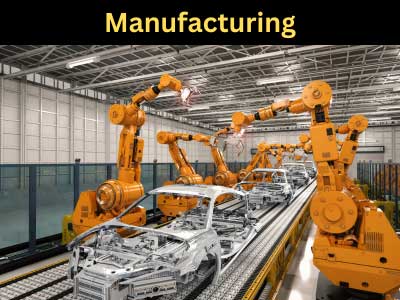Key Takeaway
Industrial robots play a crucial role in manufacturing, and the most common types include articulated robots, SCARA robots, delta robots, Cartesian robots, and collaborative robots (cobots). Articulated robots, with their rotary joints, are highly versatile and used for tasks like welding and assembly. SCARA robots excel in high-speed, precise tasks like pick-and-place operations.
Delta robots are ideal for fast and delicate tasks, while Cartesian robots offer precision in tasks requiring linear movement. Collaborative robots, or cobots, are designed to work alongside humans, enhancing safety and flexibility in manufacturing environments. Choosing the right type depends on your specific manufacturing needs.
Articulated Robots and Their Applications
Articulated robots are perhaps the most recognizable type of industrial robot, characterized by their jointed arm design, which resembles the movements of a human arm. These robots typically have multiple axes, ranging from four to six, allowing for a wide range of motion. Articulated robots are highly versatile and are used in various applications such as welding, material handling, assembly, and painting.
One of the main advantages of articulated robots is their flexibility. With their ability to move in multiple directions, these robots are ideal for tasks that require precision and dexterity. For example, in automotive manufacturing, articulated robots are often used for tasks like welding car frames, where accuracy and strength are critical.
Additionally, their design allows them to operate in tight spaces, making them suitable for complex assembly operations. While they are incredibly efficient, it’s important to ensure proper programming and maintenance to keep them operating at peak performance.

SCARA Robots for Precision Manufacturing
SCARA (Selective Compliance Assembly Robot Arm) robots are known for their precision and speed in assembly and pick-and-place tasks. Unlike articulated robots, SCARA robots have a simpler design, typically with four axes, and are used in applications that require horizontal movement and minimal vertical flexibility. Their rigid structure makes them ideal for high-speed, repetitive tasks with precision.
SCARA robots excel in industries such as electronics and pharmaceutical manufacturing, where small parts assembly or component placement is crucial. These robots are commonly used for tasks like inserting components into printed circuit boards or packaging pharmaceutical products.
The key advantage of SCARA robots lies in their speed. Their compact, rigid structure allows for fast movements with minimal vibration, ensuring that precision is maintained even at high speeds. For manufacturers looking to increase throughput without sacrificing accuracy, SCARA robots are a reliable solution.
Cartesian Robots for Linear Movements
Cartesian robots, also known as gantry or linear robots, are built on three linear axes (X, Y, and Z) that move in straight lines, making them perfect for tasks requiring straight-line motion. Their simple design and ease of programming make them a popular choice for applications such as CNC machine operation, 3D printing, and automated pick-and-place operations.
One of the main advantages of Cartesian robots is their high level of accuracy, especially for tasks that require precision over long distances. Because their movement is restricted to linear motions, they excel in tasks where positioning is crucial, such as in material handling or cutting operations.
Cartesian robots are also highly scalable, meaning they can be adapted to different sizes and tasks depending on the needs of the manufacturer. Their straightforward design allows for easy integration into automated systems, making them a cost-effective solution for many industries.
Collaborative Robots (Cobots) in Manufacturing
Collaborative robots, or cobots, represent a new wave of industrial robotics designed to work alongside human workers. Unlike traditional robots, which are often separated from humans for safety reasons, cobots are equipped with advanced sensors and safety features that allow them to operate in close proximity to humans without the risk of injury.
Cobots are particularly useful for tasks that require a combination of human skill and robotic precision. For example, in manufacturing environments, cobots can handle repetitive tasks like screwing or fastening components while the human operator focuses on more complex or delicate tasks. This collaboration between humans and robots increases overall productivity and reduces the strain on human workers.
The flexibility and ease of programming make cobots an attractive option for manufacturers looking to automate certain processes without replacing their workforce. Cobots can be quickly reprogrammed for different tasks, allowing for a more agile manufacturing environment that can adapt to changes in production demands.
Mobile and Autonomous Industrial Robots
Mobile and autonomous robots are becoming increasingly common in modern manufacturing, where flexibility and adaptability are key. Unlike fixed robots, mobile robots can navigate around a factory floor, moving materials, products, or tools from one place to another. These robots use sensors and mapping software to navigate around obstacles and reach their destination safely.
One example of this technology is the Automated Guided Vehicle (AGV), which follows a set path, often using magnetic strips or sensors embedded in the factory floor. Another example is the Autonomous Mobile Robot (AMR), which uses advanced mapping technology to navigate freely, making real-time decisions on the best route to take.
Mobile robots are invaluable in industries with large factory floors or where there’s a need to move materials across long distances. By automating material transport, these robots free up human workers for more value-added tasks, ultimately increasing efficiency and reducing the risk of workplace injuries.
Conclusion
Selecting the right type of industrial robot depends on the specific requirements of your manufacturing process. Articulated robots offer flexibility and precision for complex tasks, while SCARA robots excel in high-speed, repetitive operations. Cartesian robots provide linear accuracy, and collaborative robots are perfect for human-robot interactions. Finally, mobile and autonomous robots bring agility and automation to material handling.
As a new engineer, understanding these various types of industrial robots and their applications is crucial for optimizing production efficiency and meeting the demands of modern manufacturing.
